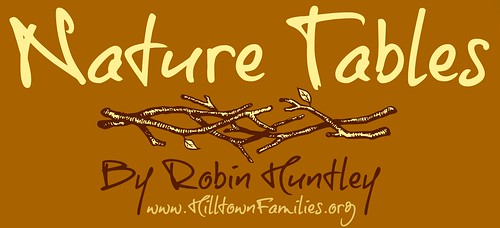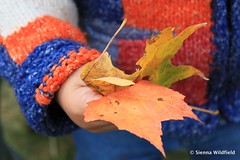Nature Table for November: Dead and Brown
Nature Table for November is Dead and Brown

Every month, Hilltown Families features a new nature table whose contents inspire learning along with a common theme easily spotted in our surroundings that month. A tradition carried out by teachers, environmental educators, and nature-curious families, nature tables bring a little bit of the outdoors inside for inspection, dissection, identification, creative play, art projects, and lots of other educational activities. The idea behind a nature table is to help open up children’s eyes to the unique attributes of each season and to help them learn how to see these things in nature for themselves. A nature table can include a variety of items and is often accompanied by a set of books and/or field guides so that children can take part in further learning at their own will.
Slowly but surely, summer’s lush green has turned into the distinct brown that both late fall and early spring wear so well. Our eyes, currently calibrated to notice bugs more than anything else, have helped us to recognize that as the season has changed, so have the habits of the creatures we’ve been watching. What we missed out on, however, was the slow change that the vegetation around us was experiencing – and now there’s nothing much left save for a few patches of hardy lawn grass.
“Wait – what happened?” tiny naturalists want to know. They’re not mystified that the change took place – being old enough to take the seasonal change for granted, they’re more in tune with nature’s details at this stage of life. So it’s not the passing of summer and the coming of winter that has us hooked, it’s the actual science behind the change.
How did the plants die?
Is plant death the same as creature death? Or human death?
And what happens next?
Theorizing together, our young naturalists were able to come up with some good guesses themselves. Almost-daily expeditions into our small patch of woods have alerted us to the fact that not all of the plants around us died at the same time. We’ve also noticed that while the early fall weather made us take off layers, we now wish we had more layers to add on. The agrarian background that some of us bring to our naturalist work told us that to keep garden plants alive; we can cover them to protect them from frost.
Do you see a pattern here? We did.

Our problem-solving led us to this conclusion: the plants begin to die as the weather starts to grow colder slowly. Now that it’s cold every day, by which nearly all of the plants around us have gone. But what’s the connection? We intuitively understood why it’s tough for a plant to survive out in the cold, but how exactly it happens remained a mystery – until today.
Here’s what happens: water expands when it freezes. Plant cells are full of water! It helps them stay alive. Plant cells are also, however, fairly rigid; their cell walls hold the contents in a specific and defined shape. When it gets cold, the water inside the plant freezes, expands, and damages the cell walls. Plants growing in a sunny spot get hit doubly hard here, as the morning sun can sometimes cause even more damage, causing cell walls to break as the water inside thaws at a faster rate than the cells are prepared to handle. One of the reasons why the plants don’t all die in unison is the differences in their structure. Some are hardier and able to withstand a few (or many) frosts. Others are less affected by the temperatures and more affected by the lack of moisture in the soil once the ground begins to freeze. Others just end their lives naturally when the process of pollination and seed dispersal is complete.
The business of cells and cell walls is primarily lost on these young naturalists, and will likely be lost of many others. To see it in action, try freezing and thawing a collection of plants. Leafy vegetables and houseplants work just fine for this test if, like us, you’ve just now realized that most everything around you has passed. Before freezing, make predictions about which leaves will fare the better, and make some conjectures as to why. Take note of the thickness, transparency, and complexity of each plant – these can be important factors! Freeze your bits of vegetation on a cookie sheet, or in some similar way that gives them direct exposure to the freezing air and doesn’t allow them to touch one another. If you live in a place where you can leave them outside for the night, go for it! If you don’t, use your kitchen freezer as the outdoors. Leave them overnight to simulate a real frost. Then, thaw them out at room temperature. You’ll notice drastic changes!
This month’s nature collection was created through a thorough search to find what’s dead already and what is not. Here’s some of what’s dead nearby:
- milkweed
- thistle
- goldenrod
- dandelions
- hostas
- pumpkins
And here’s some of what’s still green:
- lavender
- hemlock
- lawn grass
- kale
- moss
- pine
Explore the specifics of plants and seasonal change with support from these titles:
Nature’s Building Blocks: Biology for Kids, Plant and Animal Cells by Left Brain Kids
Plant Cells by Penny Dowdy
Robin Morgan Huntley, Community-Based Education Correspondent
 A native to Maine, Robin joined Hilltown Families in early 2011 as an intern and remained over the years volunteering as a community-based education correspondent until moving back to Maine in 2016. Robin is a graduate of Antioch University with a masters in education. Her interests within the field of education include policy and all types of nontraditional education. For her undergraduate project at Hampshire College, Robin researched the importance of connecting public schools with their surrounding communities, especially in rural areas. Robin currently lives with her husband, cats and rabbits in Maine and is a 5th grade public school teacher.
A native to Maine, Robin joined Hilltown Families in early 2011 as an intern and remained over the years volunteering as a community-based education correspondent until moving back to Maine in 2016. Robin is a graduate of Antioch University with a masters in education. Her interests within the field of education include policy and all types of nontraditional education. For her undergraduate project at Hampshire College, Robin researched the importance of connecting public schools with their surrounding communities, especially in rural areas. Robin currently lives with her husband, cats and rabbits in Maine and is a 5th grade public school teacher.
 Hilltown Families
Hilltown Families 




























